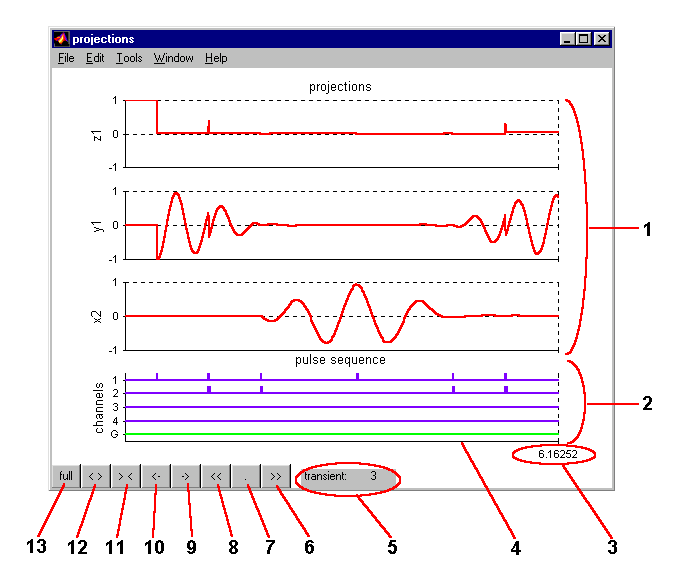The Projections Display Window

This window displays projections of the spin denstity matrix onto selected basis operator as a
function of 'real experiment' time in the course of pulse sequence.
- Projections: The graphs represent projections onto user-selected basis operators (see
Spin Setup Window), indicated on the left: z1, y1, and y2 denote Sz1, Sy1, and
Sx2, respectively, for a two-spin system.
- Pulse Program: Schematic representation of the pulse program (here: invist) in
'real experiment' time. Channels are indicated on the left, the gradient channel (G) is colored green.
- Start-of-Acquisition Time Stamp: Indicates 'real' time point when acquisition started. Note: evolution of the spin density
components during acqusition is currently not displayed, so the acquisition perios is not present in this graph.
- Time Axis: Displays 'real' time in the course of the experiment, also indicated by tick labels.
All graphs in this plot are synchronized with this axis.
- Shown Transient(s): Indicates currently displayed transient(s).
Display/View Port Controls:
- Next Transient: Display the whole time period corresponding to the next transient;
- Current Transient: Display the whole time period corresponding to current transient. If more than one transient
was displayed prior to clicking on this buttom, the transient corresponding to the middle of the displayed time
range will be selected as current transient;
- Previous Transient: Display the whole time period corresponding to the previous transient;
- Right Shift: Shift the view port to the right (graph is shifted to the left);
- Left Shift: Shift the view port to the left (graph is shifted to the right);
- Zoom Out: Compress the graph;
- Zoom In: Expand the graph;
- Full Graph: Display full graph, no zoom;
Also, the graph can be zoomed in using mouse (Note: in this case, the current transient(s) indicator might not be updated properly):
- select one edge of the desired region (left or right), anywhere in the graph area -- the vertical
position does not count;
- press and hold the right mouse button and drag the mouse horizontally till it reaches the other end
of the desired region;
- release mouse button, the zoomed-in window will be displayed automatically.
BACK TO MAIN VNMR VINDOW
BACK TO VNMR MANUAL
Back to top
Page designed by David Fushman & Peter Nicholas. Modified 11/28/2001.

